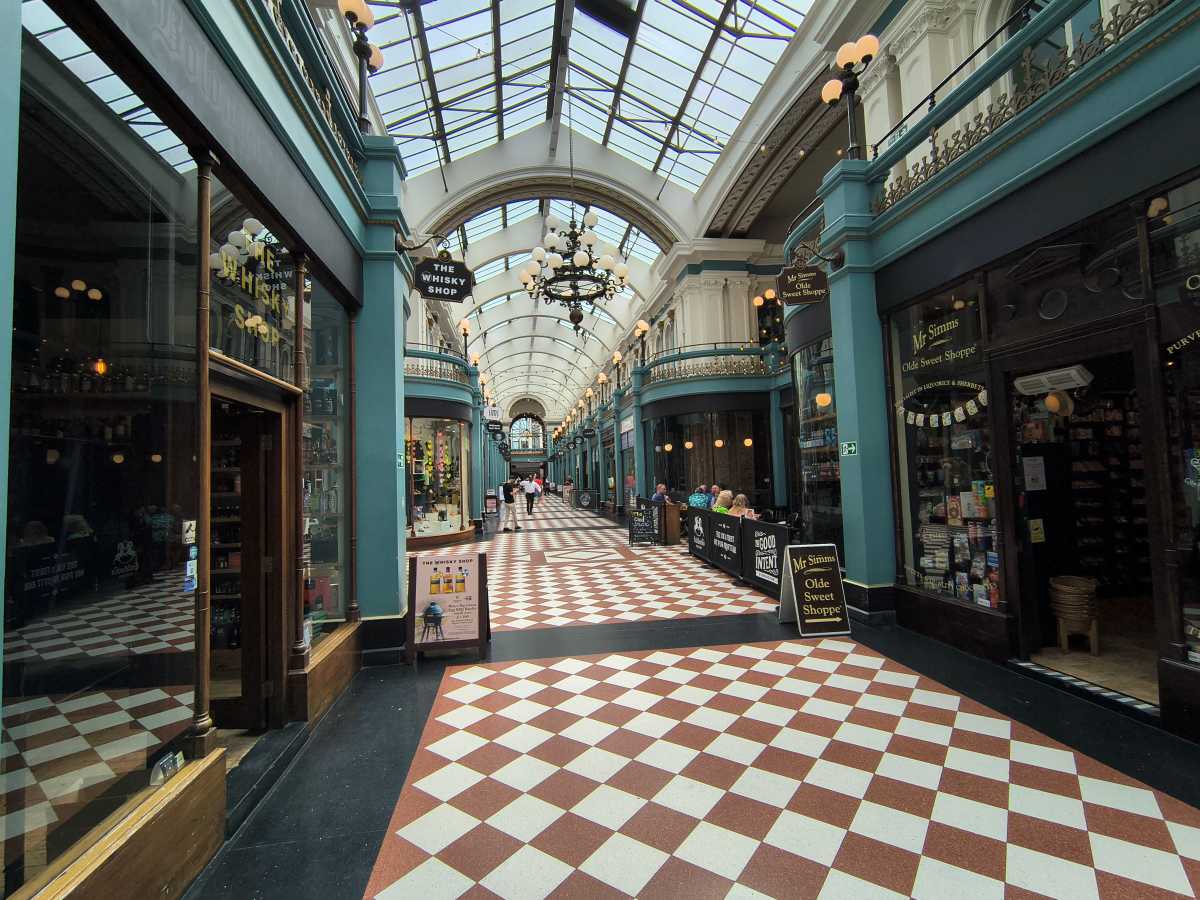Expert’s Rating
Pros
- Affordably priced for a foldable
- Cover display actually useful now
- Vegan leather design attractive and practical
Cons
- Poor performance for the money
- Mediocre cameras
- Much cheaper in the US than the UK
Our Verdict
The Motorola Razr 50/Razr (2024) supplies a broadly comparable experience to the high-end model in a much cheaper package, with a new and vastly improved cover display. Performance and camera quality aren’t quite where we’d like, but the Razr 50 still makes the Galaxy Z Flip 6 look downright expensive.
Best Prices Today: Motorola Razr 50

$899.99
Foldable phones are prohibitively expensive. That’s what we all thought until the Motorola Razr 40 arrived in 2023, shaving hundreds off the price of the equivalent Samsung Galaxy Z Flip thanks to some generally well-judged compromises.
As another year goes by with neither a price cut nor a significant upgrade on the Galaxy Z Flip 6, it falls on the Motorola Edge 50 to represent the value for money pick. The Nubia Flip 5G is even cheaper, but there are significant compromises there.
It doesn’t have the cutting edge features of the flagship Motorola Edge 50 Ultra, which we reckon is the best foldable for most people right now, but it sets out to offer a broadly equivalent experience for way cheaper. Is that still enough in 2024?
It’s worth noting for our US readers that the Motorola Razr 40 and the Motorola Razr 2024 are one and the same. We’ll be referring to the phone by the former, as its internationally adopted name, but everything we say about the Razr 50 also applies to the Razr 2024. There’s one noteworthy difference, but we’ll point that out at the appropriate moment.
Design & Build
- Vegan leather back comes in three colours
- Expanded cover screen
- Now IPX8 rated
Motorola produced an appealing clamshell foldable design in the Razr 40, and it’s stuck with much the same blueprint for the Razr 50. This is a much softer, warmer device than the cold and industrial Samsung Galaxy Z Flip 6.
The aluminium frame is rounder, and it melds into the edges of the Corning Gorilla Glass Victus-coated cover display. Meanwhile, the rear panel and a small strip of the opposite half are covered in vegan leather.
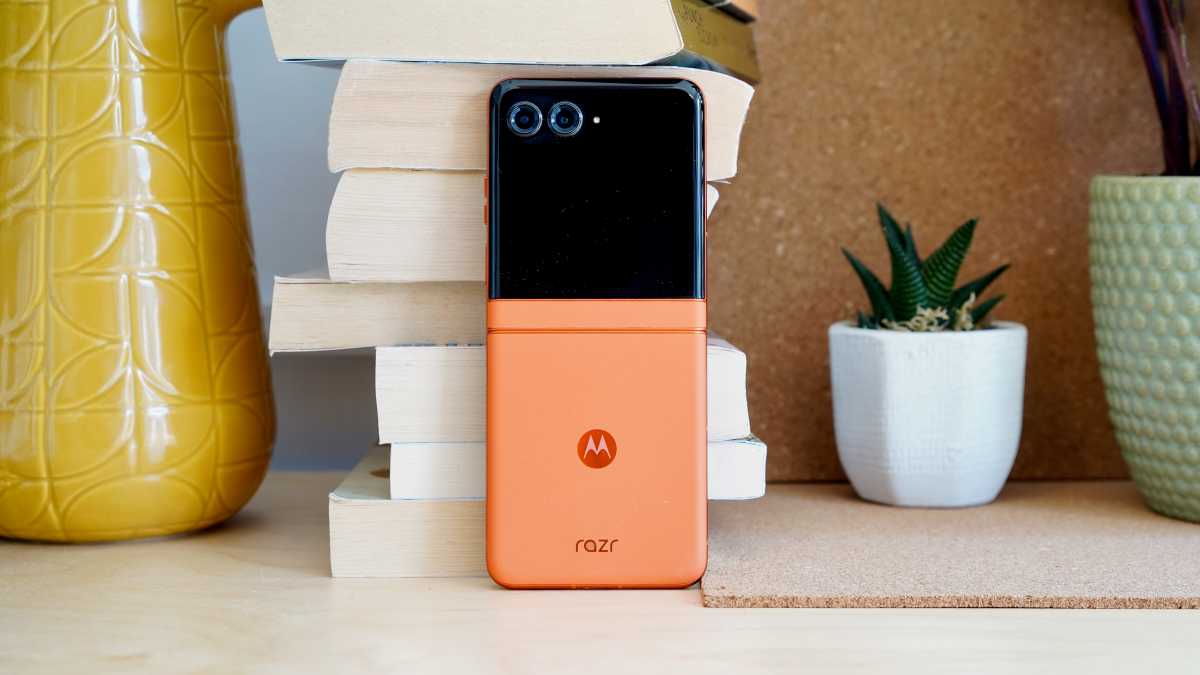
Jon Mundy / Foundry
This material is essentially made of plastic, but it features a grippy texture that approximates that of real leather. Besides a distinctive look and feel, it makes the Razr 50 feel more solid in the hand, which is a welcome feeling when you’re constantly prying it open via a tightly sprung hinge.
Talking of which, I found the Razr 50 hinge to be easier to manipulate than the Galaxy Z Flip 6, though it’ll only hold position from around the quarter-open point.
It also made me feel far more comfortable sitting the Razr 50 down on a flat public surface, such as a wall, to make use of the clever remote selfie feature that we’ll go on to discuss. With the Flip 6, I was always worried that I would scratch the glass back in such a scenario.
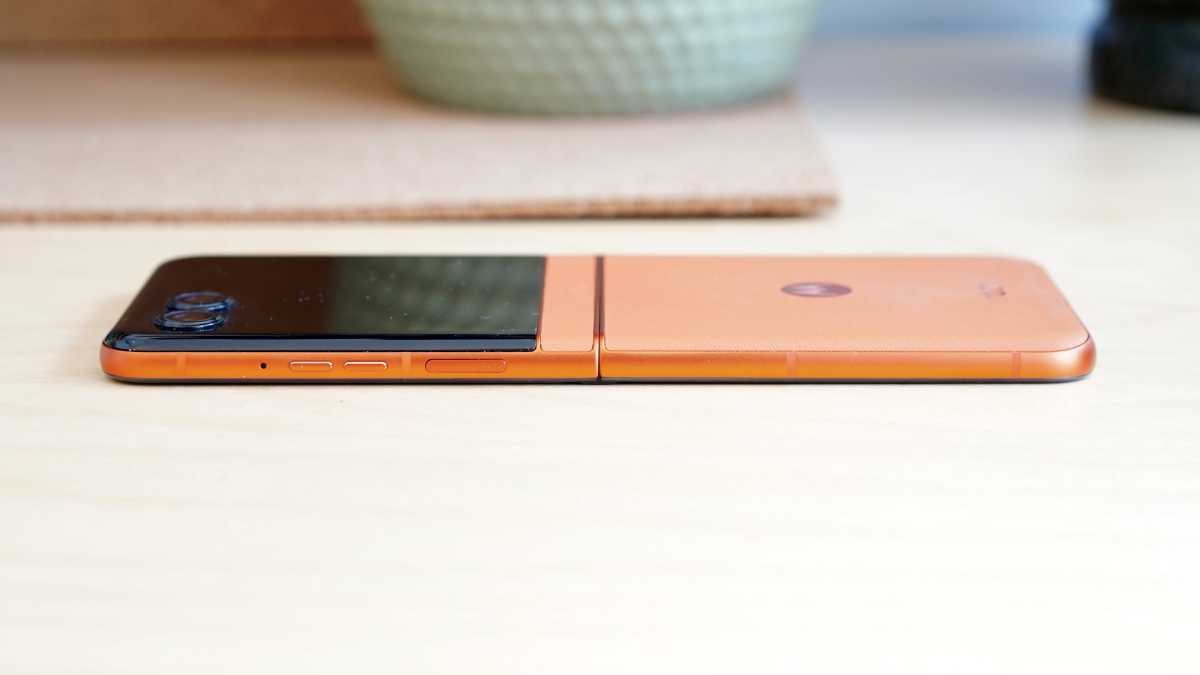
Jon Mundy / Foundry
That strip of vegan leather on the top half of the phone is way smaller than before (albeit still bigger than the all-screen Razr 50 Ultra), because Motorola has massively increased the size of the cover display. We’ll go into the details more in the next section, but suffice to say that the Razr 50 no longer feels like an obviously compromised foldable like its predecessor.
The Razr 50 no longer feels like an obviously compromised foldable like its predecessor
The Razr 50 isn’t as skinny as the Flip 6, though 7.25mm when open is nothing to be sniffed at. It’s when it’s closed up that it feels a little more substantial, although a thickness of 15.9mm is offset by those rounded edges and a small, square footprint. It’s not very heavy, either, at 188g.
Motorola has bolstered the water resistance rating to IPX8, meaning I felt far more secure handling it near water. The weak point continues to be the non-existent official dust resistance, but then even Samsung has been unable to fully close up all those hinge gaps. End result: you still won’t feel comfortable taking the Razr 50 to the beach, especially not with the same soft plastic inner display.
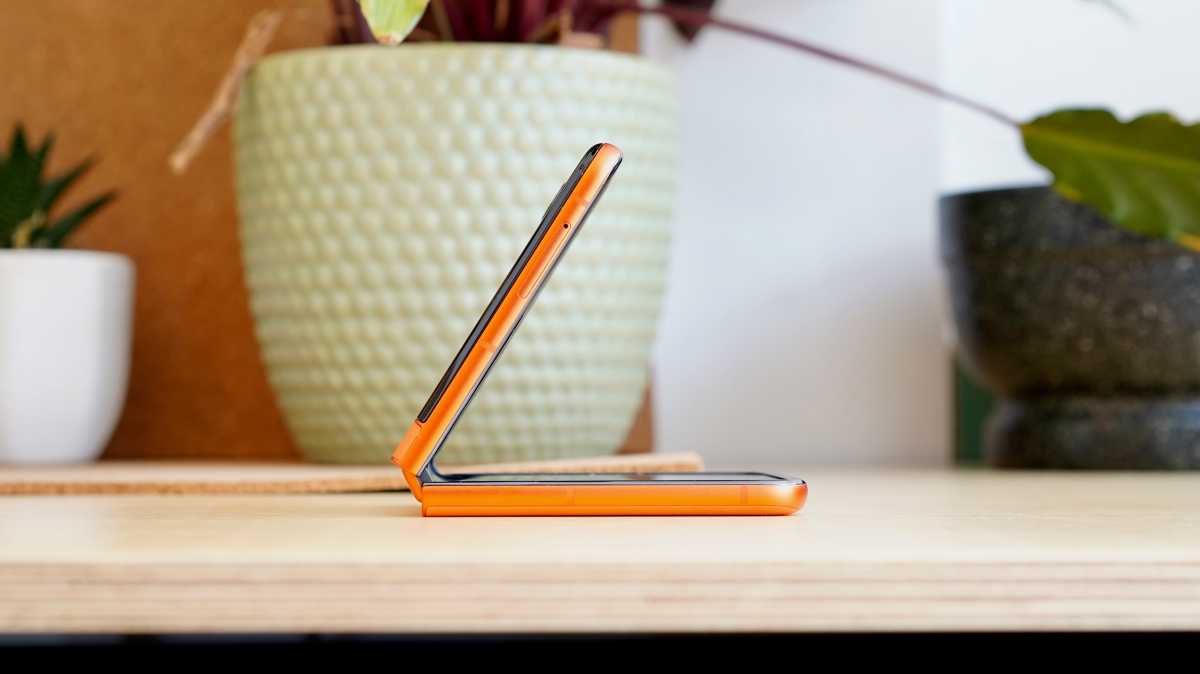
Jon Mundy / Foundry
Special shout out to Motorola for my model’s Spritz Orange colour, which combines a bright terracotta vegan leather with a deeper burnt orange for the metallic rim. The other options, Koala Grey and Beach Sand, offer more sober tones if you prefer.
There’s a responsive fingerprint sensor under the flat power button on the right edge, the use of which shows off the phone’s decent – if not top class – haptic feedback. It’s not very easy to use when the phone is out of hand, though, such as when you’re trying to position the camera for a scenery or group shot.
Screen & Speakers
- Creaseless 6.9-inch internal display
- 3.4in cover display now actually useful
- Internal screen refresh rate now 120Hz
The main story with the Razr 50 isn’t its 6.9-inch internal AMOLED display, but rather its new cover screen. Last year’s Razr 40 supplied a weedy 1.5in example that felt somewhat dated. This year’s version is greatly expanded to 3.6in, with a 1056 x 1066 resolution and a 90Hz refresh rate.
This makes it larger, sharper, and more fluid than the Galaxy Z Flip 6 equivalent. It also envelops the twin camera modules, rather than cutting them off at an awkward angle like the Flip. It’s worth pointing out that the Samsung Galaxy Z Flip 6 is a significantly more expensive phone, too.
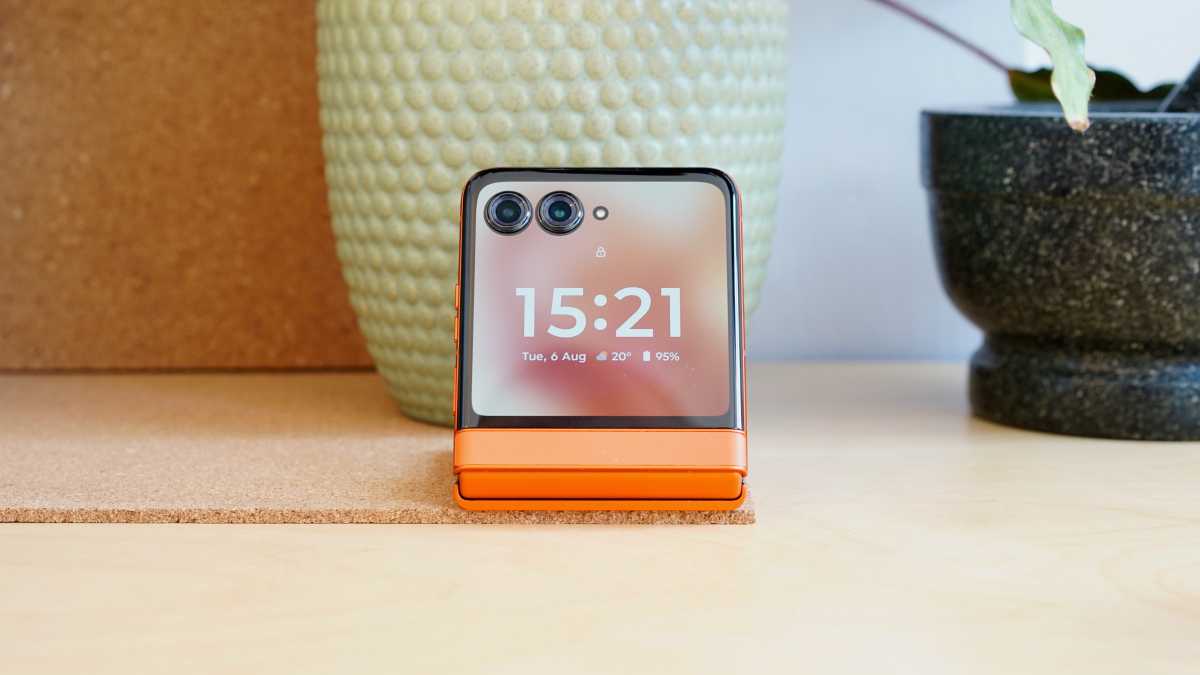
Jon Mundy / Foundry
All of this means that the Razr 50 cover display can boast the same functionality as the Razr 50 Ultra, despite being a little smaller. You can run certain full apps on this screen, though it’s still better suited to heads-up widgets like those of the Galaxy Z Flip series.
Even so, the extra screen space and resolution means the Razr 50’s cover screen is much more pleasant to interact with than the Galaxy Z Flip 6’s. I found the Weather and Calendar widgets to be the most useful here, both offering an interactive rundown of the day’s forecast. The YouTube Music widget is another handy one, letting you skip and pause without having to open the phone.
The inner screen is still where most of your interaction will be done, though. It’s a large 6.9-inch LTPO AMOLED with a 120Hz refresh rate. The latter actually represents a drop from the Razr 40’s 144Hz, but it’s a smart compromise. This always felt like overkill, especially when battery life savings are so important.
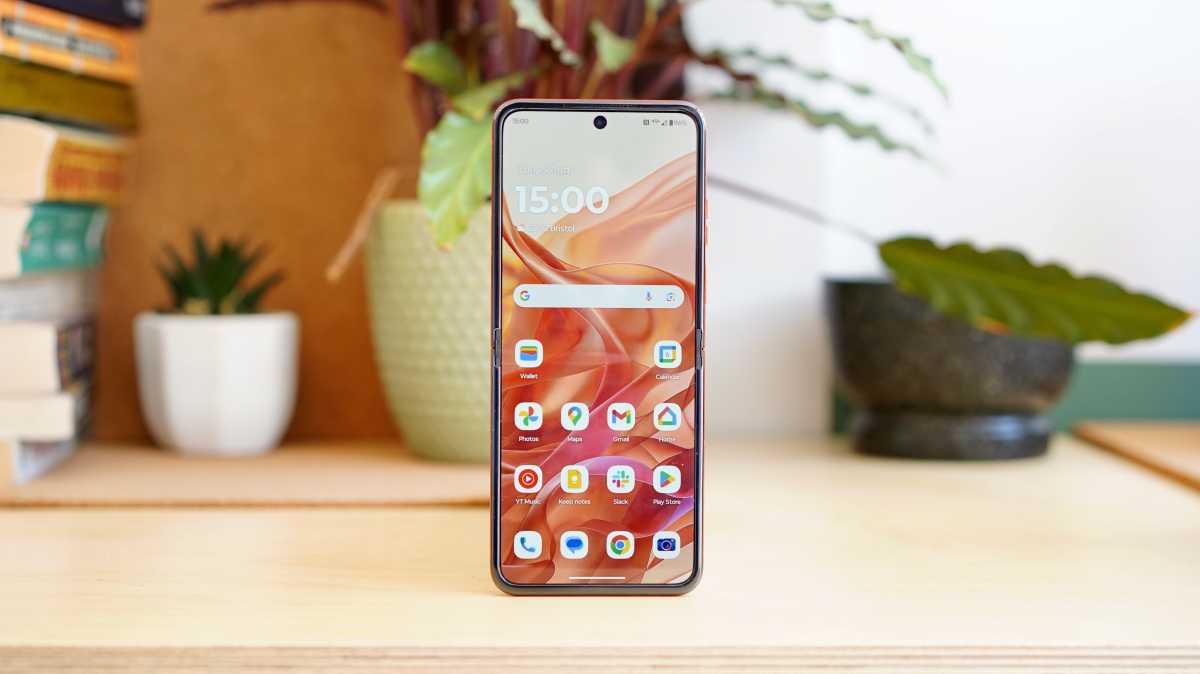
Jon Mundy / Foundry
This main screen can reportedly hit a peak brightness of 3000 nits, though this is a localised figure with HDR content. With auto brightness switched off, I recorded a full-screen brightness of 492 nits, which is decent, if not up there with the best non-foldable flagships.
It’s still a very tall screen, which requires a second hand to be brought into play for almost any interaction. But with the expanded cover display now able to handle single-handed interactions, that’s less of an issue than before.
The Razr 50’s cover screen is much more pleasant to interact with than the Galaxy Z Flip 6’s
Also, credit to Motorola’s designers for getting very close to the creaseless ideal for a flip phone. You can still see and feel that kink half way up the screen when it’s open, but it’s not massively apparent.
That display is flanked by a pair of stereo speakers, but they really aren’t all that good. The sound output is thin and reedy, certainly compared to flagship non-foldables available for around this sort of money.
Specs & Performance
- Mediatek Dimensity 7300X not a great performer
- 8GB RAM
- 256GB storage
Motorola has evidently made some savings by switching away from the mid-range Snapdragon 7 Gen 1 chip of the Razr 40 and adopting the Mediatek Dimensity 7300X.
It’s a roughly equivalent mid-range processor, meaning it results in very similar CPU and GPU performance. The lack of progress here is a bit of a shame, especially as the Razr 40 was hardly considered a top performer at the time of its release.
My time with the Razr 50 wasn’t without its instances of lag and stutter in regular and fairly low-intensity situations. It doesn’t unlock with the snap for a genuine flagship, for example, while I experienced the odd micro-pause during navigation, or when jumping between open apps.

Jon Mundy / Foundry
It doesn’t feel slow, exactly. It just felt like I was catching it on the hop from time to time. The provision of 8GB of RAM is a little on the low side, but should be more than enough to run day to day tasks fluidly. There is a 12GB variant of the Razr 50 out there, but not in the UK or the US.
My time with the Razr 50 wasn’t without its instances of lag and stutter in regular and fairly low-intensity situations
In gaming terms, Genshin Impact defaults to the lowest graphical settings, and remains playable – if far from silky-smooth – on Medium settings. If you’re expecting a gaming powerhouse at this price, look for something without a hinge.
At least this solitary model provides a decent 256GB of storage. There’s no Micro-SD slot to expand that capacity, but it shouldn’t be a problem for the vast majority of people.
Motorola Razr 50 benchmarks
Cameras
- 50Mp main camera
- 13Mp ultrawide
- 32Mp front, but main camera is way better at selfies
Rather impressively, the Razr 50 shares its main camera with the pricier Razr 50 Ultra. It’s the same 1/1.95″ 50Mp f/1.7 sensor with PDAF and OIS.
With an inferior processor onboard and the lack of Motorola’s Photo Enhancement Engine, however, this doesn’t result in images of equal quality. Indeed, the Razr 50 has an even worse habit of pumping up colours to an unnatural degree.
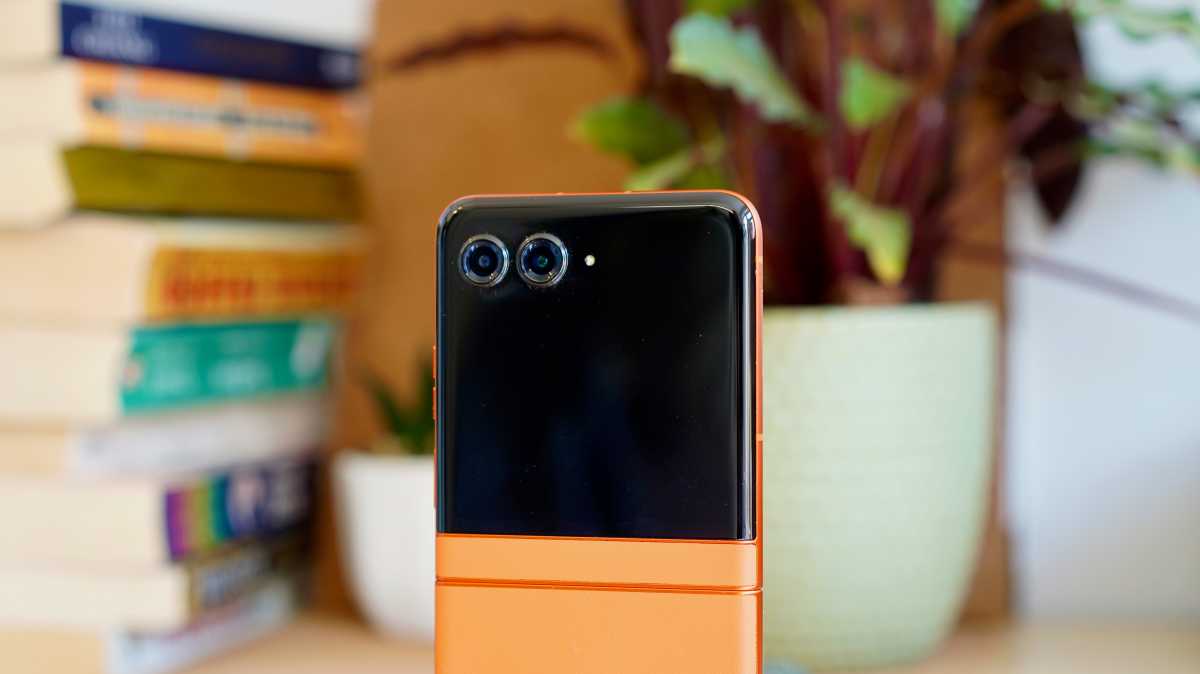
Jon Mundy / Foundry
Whether taking pictures of people, sushi, or flowers, I found snaps to be over-processed. At times, they were positively luminous. In bright conditions, there was plenty of detail, and reasonable HDR implementation, but I also noticed some blown out highlights. In certain other indoors shots, where the lighting was moderate, I was able to get some well-balanced results.
Night shots aren’t anything to write home about though, with a slightly flat look and loads of glare from artificial light sources. Again, it can do a job, but you might expect better.
Motorola has stuck with a more traditional 13Mp ultra-wide here, rather than following the Ultra and switching to a 2x telephoto. I’m not particularly for or against either approach, as long as the resulting shots are decent. All I’d say is that 2x cropped shots using the main camera have come a long way, and there’s no way to satisfyingly take ultra-wide shots in a similar fashion.
Either way, the ultra-wide shots here lack the clarity and sharpness of the main sensor. They’re adequate, but you might hope for better. Something like the Pixel 9 or the Galaxy S24 would certainly get you better ultra-wide results.
Just about the only pictures that truly impress here are selfies, and that’s got nothing to do with the dedicated 32Mp front camera. It’s perfectly adequate, but largely relegated to video call duty thanks to the Razr 50’s foldable nature.
The cover display defaults to showing a camera preview, which means that you can use the main camera for selfies. The quality of these compared to those from the front camera is miles better. Check out these two shots, the left-hand of which uses the selfie cam while the other uses the main-camera-and-cover-display combo.


Motorola includes some nifty little UI features for such selfies too. You can have an animated smiley face appear to make your subjects smile (which proved very successful, at least the first few times I deployed it). You can also prop the phone up on a flat surface, half opened, and hold your palm to the camera to start a countdown timer before the photo is taken. It works like a charm.
Whether taking pictures of people, sushi, or flowers, I found snaps to be over-processed
Hold the phone half-folded and on its side with the camera app open, and it’ll enter camcorder mode, counting down from three to start automatically recording. Said video footage can hit up to 4K at 30fps, or 1080p at 60fps.
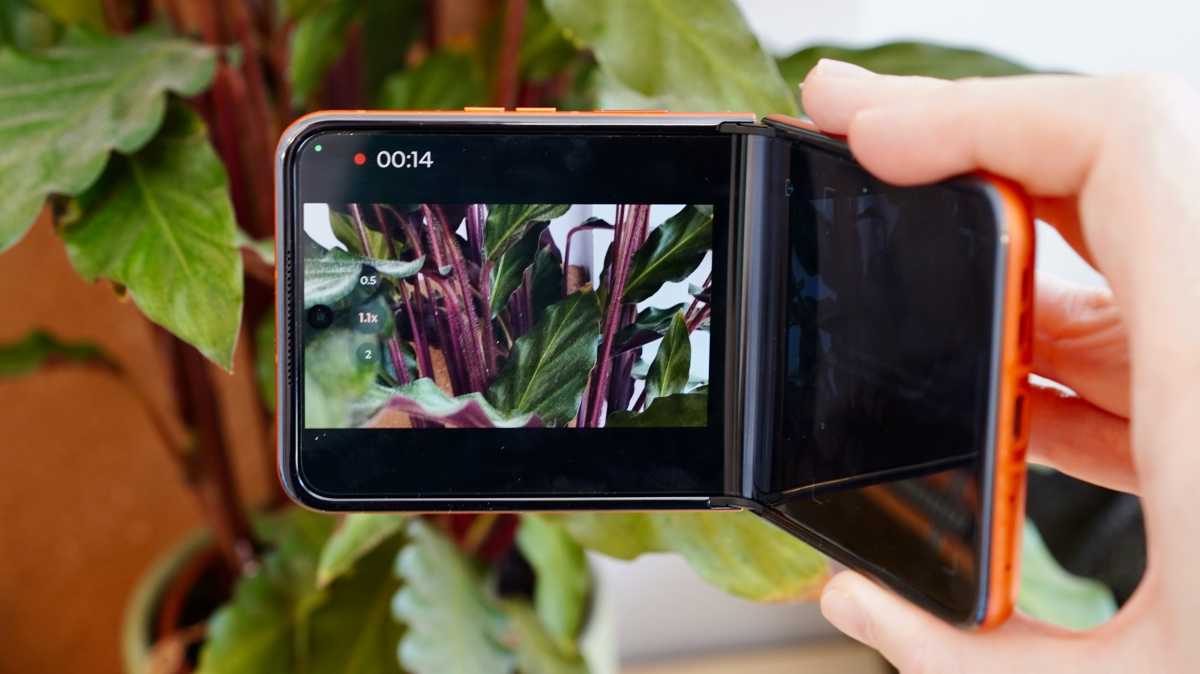
Jon Mundy / Foundry
Battery Life & Charging
- 4200mAh battery
- 30W wired charging support
- 15W wireless charging
Motorola has gone with the same 4200mAh battery in the Razr 50 as it did with the Razr 40. This means that it’s actually larger than the 4000mAh Razr 50 Ultra.
Not that this resulted in superior battery life, unfortunately. In our standard PCMark battery test, the Razr 50 managed 10 hours and 41 minutes. That’s about 25 minutes longer than the Razr 40, but more than 2 hours short of the Razr 50 Ultra.
Given that the Ultra has a bigger, more fluid external display to power, I can only conclude that the Ultra’s more impressive and power efficient processor gains it those extra hours.
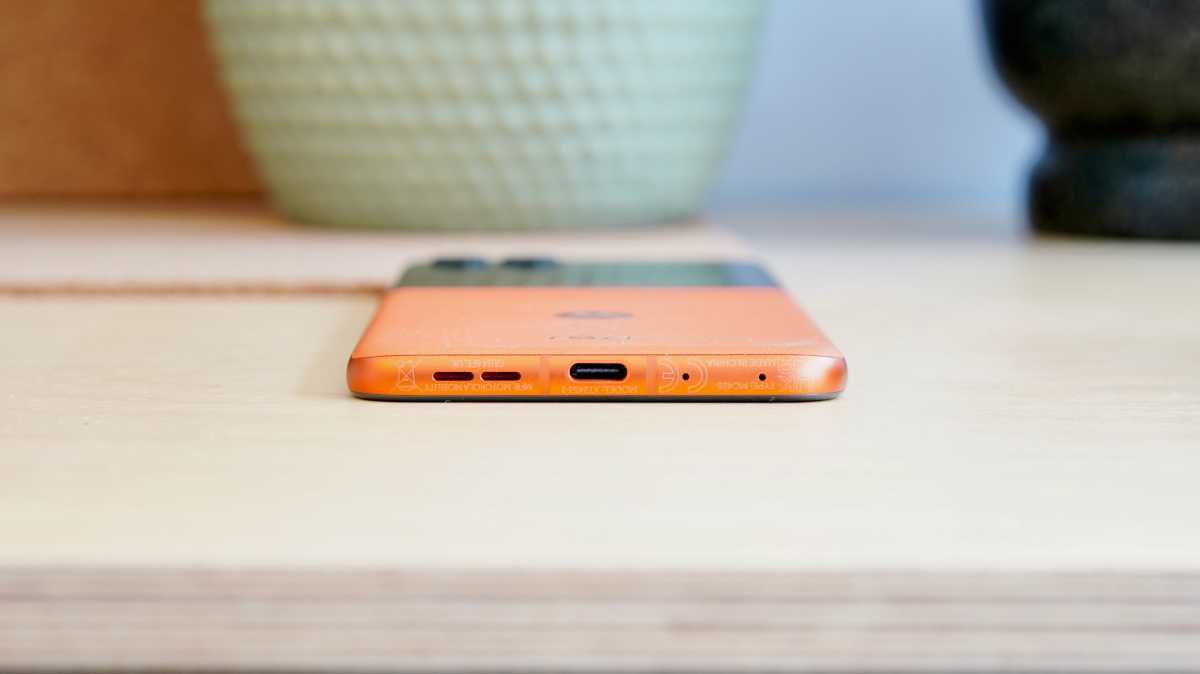
Jon Mundy / Foundry
This test reflects more intensive conditions. During my own practical use, which I’d describe as fairly moderate, I was routinely able to get through a full day with around 50% battery left. It’s got genuine two-day potential if you’re a lighter user, which is just the audience these compact foldables are intended for.
I was routinely able to get through a full day with around 50% battery left
The wired charging provision is the same unimpressive 30W as before, but you don’t even get a charging brick in the box this time. Using an Asus 30W charger, I was able to get the phone from empty to 63% in half an hour, and to a full charge in a little under an hour.
Wireless charging has taken a small boost from the Razr 40, moving up from 5W to 15W when using an appropriate Qi charger.
Software & Apps
- Android 14
- Clean and quite close to stock
- Three Android versions, four years of security updates
The Razr 50 runs on Android 14, with Motorola’s light embellishments sprinkled over the top.
It’s not totally free from bloat – did we really need the Opera web browser preinstalled alongside Chrome? Spotify, TikTok, and even Facebook are probably justifiable due to their ubiquity, but I would still rather have been given the choice at set-up. There’s never any excuse for LinkedIn, though, especially on this most un-businesslike of phones.
Motorola’s embellishments are usually well received, and nowhere is that more apparent than within the Moto app. This stylish, streamlined app serves as an introduction to everything extra Motorola has to offer.

Jon Mundy / Foundry
You can access all of the available gestures through this app. By default you can do things like double-chop to turn on the torch or double twist to jump into the camera app. But you can also activate lift to unlock, flip for do not disturb, and other handy physical actions.
Much of what’s here is common to any regular Motorola smartphone from the past few years, so let’s turn to the company’s foldable features. We’ve discussed some of the camera benefits in the previous section, which leaves that external display.
The interface is like a shrink-wrapped take on the main UI, together with drop-down control centre and swipe-up-and-hold app switcher menu.
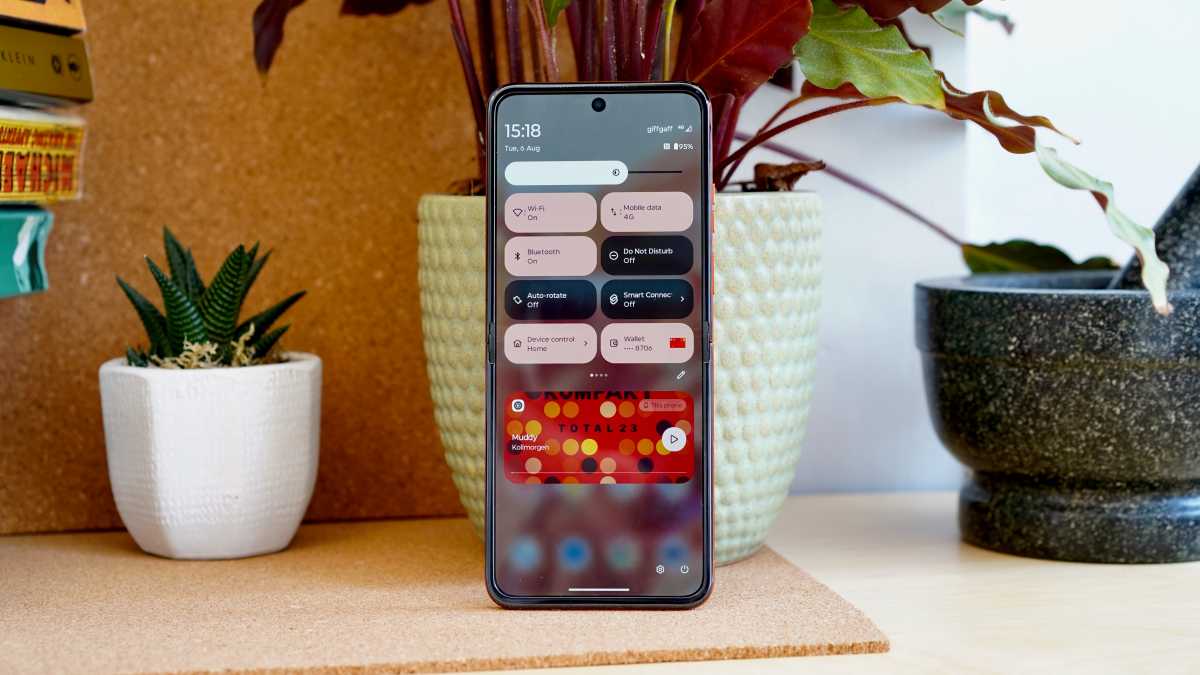
Jon Mundy / Foundry
You can run a number of apps in reduced fashion from the Razr 50’s 3.6-inch cover display, including Google apps like Photos, Gmail, Maps, and Messages. You can also run Google’s Gemini AI assistant here, which is something you can’t do on the Galaxy Z Flip 6.
Even so, the confined nature of the cover display makes it better suited to widgets and simple notifications than full apps. On the widget front, you can add full-screen applets for the likes of Weather, Calendar, and your chosen music player.
The confined nature of the cover display makes it better suited to widgets and simple notifications than full apps
The Motorola Razr 50 comes with the promise of three main Android OS updates and four years of security updates. That’s fine for most people, but not all that hot by modern foldable standards, where the Galaxy Z Flip 6 offers seven years of both.
Price & Availability
In the UK, Motorola Razr 50 is available direct from the Motorola website, as well as via third-party retailers including Amazon, for £799.99.
In the US, the same model (known as the Motorola Razr 2024) is also available from the Motorola website and via Amazon, but it only costs $699.99.
On contract, see the best options below.
That outright price is £200/$300 cheaper than the Razr 50 Ultra, and £250/$400 cheaper than the Samsung Galaxy Z Flip 6.
It’s still towards the expensive end of things in smartphone terms, but it feels downright cheap for a foldable phone. The only phone that undercuts it is the Nubia Flip 5G, but that phone makes way more compromises to hit its £499/$499 price tag.
See more alternatives in our guide to the best folding phones.
Should you buy the Motorola Razr 50?
With the Razr 50, Motorola has brought its entry-level foldable more in line with the premium Razr 50 Ultra. The simple addition of a larger, more functional cover display has made the Razr 50 into a viable alternative.
It would feel downright cheap if it weren’t for the US model, known as the Razr 2024, which is priced significantly lower.
It’s good to see the main camera getting some love, with a superior main 50Mp sensor that matches the Razr 50 Ultra. However, a lack of advanced processing smarts means that the shots aren’t as advanced, which might be a little tough to accept when you’re paying this much. The lack of progress when it come sto performance is disappointing, too.
With all that said, the Razr 50 remains the most compelling foldable entry point on the market, undercutting Samsung’s broadly comparable Flip 6 while providing a phone that’s arguably more satisfying to use.
Specs
- Android 14
- 6.9-inch FHD+, OLED, 120Hz, foldable display
- Side-mounted fingerprint sensor
- Mediatek Dimensity 7300X
- 8GB RAM
- 256GB storage
- 50Mp, f/1.7 main camera
- 13Mp f/2.2 ultra-wide camera
- Up to 4K @ 30fps rear video
- 32Mp front-facing camera
- Stereo speakers
- Dual-SIM
- Wi-Fi 802.11 a/b/g/n/ac/6e
- Bluetooth 5.4
- 4200mAh battery
- 30W charging
- 73.99 x 171.30 x 7.25 mm (open), 73.99 x 88.08 x 15.85 mm (folded)
- 188g
- Launch colours: Meteorite Gray, Moonlight White, Celestial Blue



